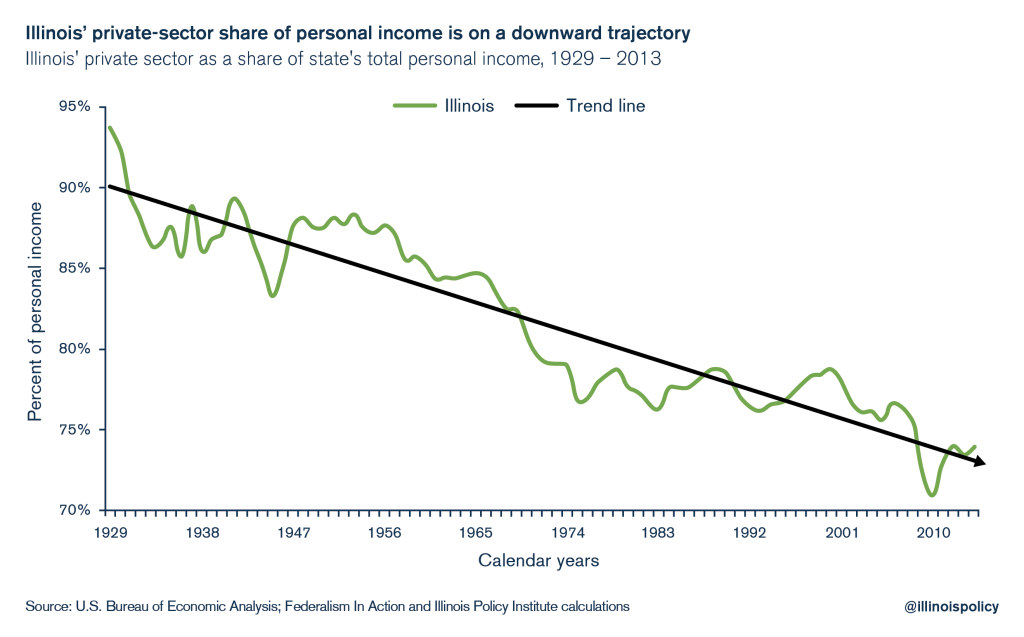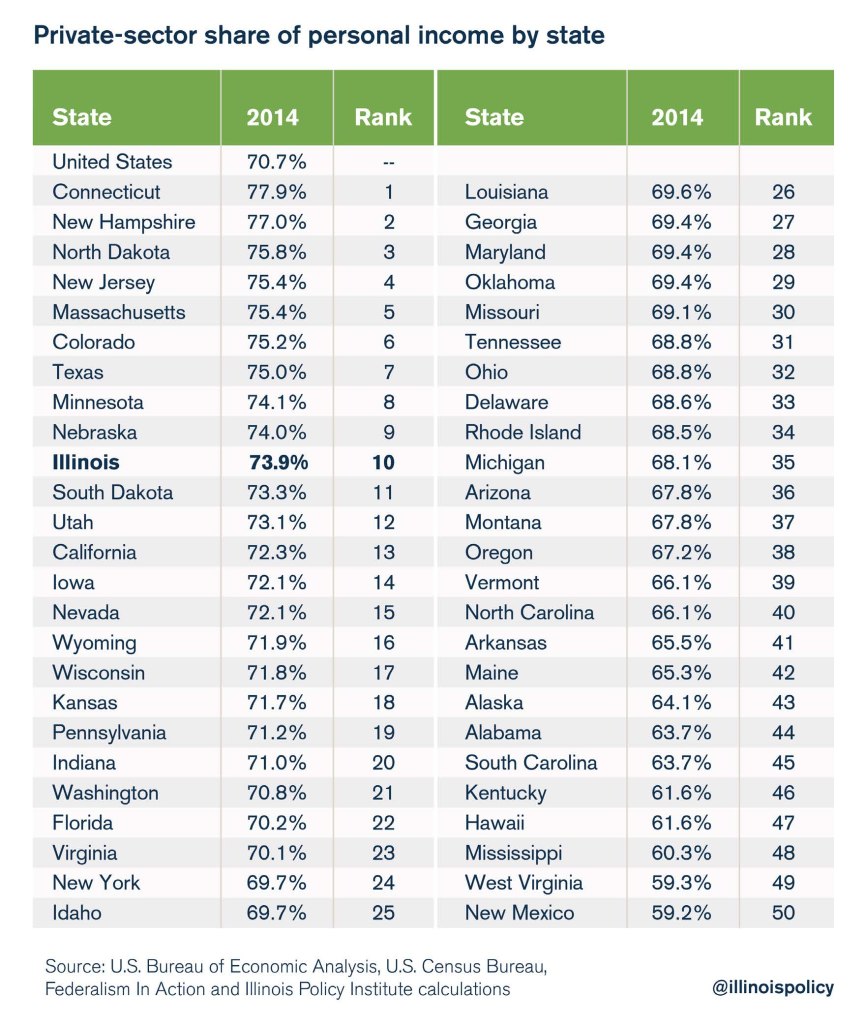Government spending in Illinois (federal, state and local) already makes up more than 25 percent of the state’s economy, but many politicians, social institutions and think tanks continue to call for ever-higher government spending, claiming that more spending will result in additional economic growth. Pro-government-spending groups justify the benefits of government spending via the so- called Keynesian multiplier, which posits that an increase in government spending eventually leads to added business activity and economic growth.
But the multiplier ignores a fundamental fact: that for the government to spend money, it needs to first take it away from taxpayers and the private sector. By focusing only on the effects of government spending, pro-spending groups ignore the cost of depriving taxpayers of their hard- earned money and the impact it has on private-sector jobs growth.
In fact, Illinois has already paid a steep economic price as government spending via transfers (Social Security, Medicare and Medicaid) and government salaries and benefits have continued to crowd out the private sector.

Illinois’ private-sector share of personal income (called the “private sector” in this report) has fallen 21.5 percentage points over the past 85 years, to 73.9 percent in 2014 from 93.7 percent in 1929. Illinois’ private sector ranked as the 10th largest in the country in 2014 – lower than it has been in years past.

Even though the government now controls a full one-fourth of the state’s economy, there are still voices that clamor for more government spending, especially for “free” federal dollars.
But any increase in government spending comes at a price. On average, a one-percentage-point decrease in the size of the private sector yields a decrease in per-household income of approximately $3,308. For Illinois, that’s a loss of $16 billion in total household income, everything else being equal.
So, while government spending may help its direct beneficiaries in the short run, the net loss of economic activity it causes means all Illinoisans are poorer overall.
THE ECONOMIC PRINCIPLES IN PLAY
More government spending ultimately makes Illinois less competitive. By crowding out the private sector, government spending actually reduces economic activity – only the private sector can efficiently generate new income and wealth in an economy. This fact runs contrary to the so-called Keynesian multiplier analysis that ignores this basic economic principle.
Government spending is the redistribution of income first extracted by taxes. Yet, the very process of redistribution comes at a very high economic cost. Prominent Harvard economist Martin Feldstein states:
“The appropriate size and role of government depend on the deadweight burden caused by incremental transfers of funds from the private sector. The magnitude of that burden depends on the increases in tax rates required to raise incremental revenue and on the deadweight loss that results from higher tax rates. … Recent econometric work implies that the deadweight burden caused by incremental taxation (the marginal excess burden) may exceed one dollar per one dollar of revenue raised, making the cost of incremental government spending more than two dollars for each dollar of government spending.” 1
Economists Stephen Brown, Kathy Hayes and Lori Taylor released a study at the state level that sheds light on the government “investment” versus “tax” debate. They find that:
“If anything, most public services do not appear to justify the taxes needed to finance them. Any tax savings financed by slower growth in environmental services, health and hospitals, or elementary and secondary education is positively associated with growth in private capital. Similarly, any tax savings financed by slower growth in public safety or education spending is positively associated with growth in private employment. … [T]his finding would seem to imply that other state and local public capital has been increased to the point of negative returns, perhaps because a growing stock of other public capital is indicative of an increasingly intrusive government.” 2
More recently, economists Taehyun Kim and Quoc H. Nguyen also come to similar conclusions:
“To summarize, we find strong evidence that support the hypothesis that government spending crowds out firm investment. We further provide novel and direct evidence that limited mobility of workers is an important channel through which the crowding- out effect can occur.” 3
Finally, private-sector crowd-out can also manifest itself through the out-migration of private firms. Economists Xavier Giroud and Joshua Rauh find:
“In this paper we have estimated economic responses to state-level business taxation by multistate firms on both the extensive and intensive margins. We find evidence consistent with substantial responses of these firms to state tax rates for the relevant tax rules. Corporate entities reduce the number of establishments per state and the number of employees and amount of capital per plant when state tax rates increase. Pass-through entities respond similarly to changes in state-level personal tax rates, although in somewhat smaller magnitude. Our specifications suggest that around half of these responses are due to reallocation of business activity to lower-tax states.”4
WHAT HIGHER GOVERNMENT SPENDING MEANS FOR ILLINOIS’ ECONOMY
The estimated economic losses due to government spending were calculated by examining the significant positive correlation between per-household personal income and the private-sector share of personal income for 2014. When examining the lower 48 states, this analysis finds that, on average, a one-percentage-point decrease in the size of the private sector yields a decrease in per-household income of approximately $3,308.5
Put simply, the bigger the private sector’s share of personal income in a state, the greater the per- household personal income is.

STATE-TO-STATE COMPARISON: NEW HAMPSHIRE AND MAINE
Of course, correlation does not equal causation. Fortunately, two states allow for a very strong natural experiment to better show causation: New Hampshire and Maine. These two states are alike in many ways: geographically, climatically, demographically and culturally. Yet, there is one area in which the two states diverge greatly: public policy.
Between 1929 and 1950, Maine and New Hampshire had similar per-household incomes (adjusted for inflation) as well as similar shares of their private sectors as a percent of personal income. However, in 1951 Maine enacted a sales tax which led to increased public-sector spending and a crowding-out of the state’s private sector. Consequently, New Hampshire’s per- household income began to steadily pull away from Maine’s.
This trend accelerated in 1969 when Maine enacted an income tax only a few years after the federal government enacted Medicaid. With this new source of revenue, Maine was able to dramatically expand its welfare systems, especially Medicaid. In fact, as of fiscal year 2010, Maine had the third-highest percentage of population on Medicaid, at 31 percent.6
In stark contrast, New Hampshire remains the only state in the union to have not enacted, at either the state or local level, a sales or income tax.
This difference in public policy has resulted in dramatic differences in the size of each state’s private sector as a share of personal income. Between 1929 and 2014, Maine’s private sector shrank by 29.1 percent, to 65.3 percent from 92 percent. Today, the state has the 42nd-largest private sector as a percent of personal income in the country.
New Hampshire, on the other hand, has seen its private sector shrink by a much smaller 14.9 percentage, to 77 percent from 90.4 percent. It now has the second-largest private sector as a percent of personal income in the country.
Overall, New Hampshire’s private sector in 2014 is 17.9 percent larger than Maine’s – 77 percent versus 65.3 percent, respectively. Consequently, due to the positive correlation between the private sector and income, New Hampshire’s per-household income is now 38 percent higher than Maine’s – $130,498 and $94,597, respectively.
The diverging economic paths of New Hampshire and Maine demonstrate an important lesson for Illinois. By expanding government spending, Illinois will be following Maine’s downshifted economic path rather than New Hampshire’s – and all Illinois residents will be poorer as a result.

CONCLUSION
As this report’s analysis shows, higher government spending does not result in an economic “free lunch” as government-spending proponents would have everyone believe.
On the contrary, increased government spending has serious economic repercussions and negatively affects the long-term health of Illinois’ economy, leaving residents poorer as a result.
The answer to helping more Illinois families is not to increase government spending. Instead, Illinois should look to fiscal, economic and governance reforms that will reduce state government spending as well as reduce the state’s dependency on federal programs. Such reforms include:
- Passing regulatory reforms to fix Illinois’ broken workers’ compensation system and anti- business lawsuit climate
- Freezing local property taxes while granting local governments more control over their own collective-bargaining agreements
- Moving new state workers to 401(k) retirement plans and other commonsense pension reforms Illinois can enact without passing a constitutional amendment
- Making local school districts and public universities bear the pension costs of their own employees going forward
- Requiring all local school district employees to make contributions toward their own pensions by ending teacher pension “pickups” as an employee benefit
- Eliminating the state’s broken education-funding formula and creating a money-follows-the- student model in its place
- Requiring state universities and community colleges to enact spending reforms to eliminate bloated administrative staff and lower the cost of tuition
ENDNOTES
- Alaska and Hawaii are excluded, as is common practice in state analysis, due to their unique economic characteristics.







